Sensei and the Insensibles
| Sensei and the Insensibles | |
|---|---|
 | |
| Author | Jane Austen |
| Cover artist | Mr David Weaver, RA |
| Country | United Kingdom |
| Language | English |
| Genre(s) | Novel |
| Publisher | Thompson and Lee (Whitehall, London) |
| Publication date | 1809 |
| ISBN | N/A |
Sensei and the Insensibles is a novel by the English novelist Jane Austen. Published in 1809, it was Austen's second published novel, following on from her initial success with The Adventures of Mr Harley and Mr Davidson. The striking cover was by her regular artist Mr David Weaver, RA, who made full use of the increased budget that he was given following his award-winning artwork for The Adventures of Mr Harley and Mr Davidson. The book combined the zombie theme of the first book with elements of fashionable orientalism.
The story is about Elinor and Marianne, two daughters of Mr Dashwood by his second wife. They have a younger sister, Margaret, and an older half-brother named John. When their father dies, the family estate passes to John, and the Dashwood women are left in reduced circumstances. The novel follows the Dashwood sisters to their new home, a cottage on a distant relative's property next to a graveyard, where they experience an unexpected uprising of zombies. Fortunately for them, a team of seven travelling ninjas happen to be passing by at the time and come to their rescue. After many mishaps, the Dashwood sisters and their saviours prevail, and all ends well.
The book has been adapted for film several times, including the classic 1971 Ken Russell version starring Glenda Jackson as Elinor and Burt Kwouk as Kurosawa, and the controversial 2008 Gaspar Noé French-language version Vas te Faire Encule, Zombie!.
Plot summary
Frankly, there is little more to say about the confused and often self-contradictory plot than has already been stated in the summary given above. It is also clear that Miss Austen's knowledge of geography does not extend much beyond the borders of Western Europe. For example, when Kurosawa, the leader of the band of Ninjas, arrives in Barton Park, he greets Marianne by explaining that he and his fellow travellers have come all the way from Japan. Yet an entire chapter of the book is later devoted to describing (at interminable and excruciatingly inaccurate length) his early childhood in Peking.
Kurosawa is a problematic character for several reasons, and not just because of the casual (at least to modern eyes) racism of Miss Austen's descriptions of him and his countrymen. For reasons best known to Miss Austen, his name changes halfway through to Karaoke and he is subsequently referred to as "she." This has caused much critical debate (see below).
Characters
- Henry Dashwood — a wealthy gentleman who dies at the beginning of the story. The terms of his estate prevent him from leaving anything to his second wife and their children. He asks John, his son by his first wife, to look after his second wife and their three daughters. He subsequently returns as a zombie and is ultimately dispatched with a pickaxe by Em Ma the Ninja.
- Mrs Dashwood — the second wife of Henry Dashwood, who is left in difficult financial straits by the death of her husband. During the initial zombie attack, her brains are eaten by her late husband.
- Elinor Dashwood — the sensible and reserved eldest daughter of Mr and Mrs Henry Dashwood. By the end of the book, she is a skilled zombie killer, equally adept with both pickaxe and samurai sword.
- Marianne Dashwood — the romantically inclined and eagerly expressive second daughter of Mr and Mrs Henry Dashwood. She also turns out to be a ruthless slayer of the undead, although her weapon of choice is the scythe.
- Kurosawa/Karaoke - sensei and leader of the band of Ninjas.
- Em Ma - his/her most trusted lieutenant.
- Kato - the clown of the Ninjas. He is always there to provide comic relief, usually by falling over something or spilling his drink over his trousers.
Critical appraisal
Sensei and the Insensibles was generally well-received by contemporary critics, who either generously overlooked the many mistakes in the book or simply did not bother to read right through to the end. In particular, the celebrated commentator Joseph Robert Brighouse remarked that
With a jar of good ALE, a buxom WENCH and Miss Austen's NINJAS, I shall not want for PLEASURE in th'afternoon[citation needed]
More recent criticism has been less kind to Miss Austen's work, although the issue of Kurosawa's sex change provided the basis for Hermione Grrr's densely argued 1968 polemic The Sensei's Scrotum. For many years, Ms Grrr's reading was definitive until challenged in 2001 by Lara Doily's post-feminist analysis Embracing Nancy the Ninja. However, recent computer-aided textual analysis has suggested that the sex change was simply the result of carelessness on Miss Austen's part, compounded by sloppy editing.